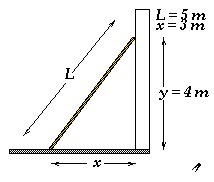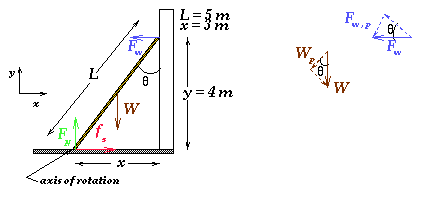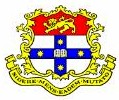2. A ladder of weight 60 Nt leans against a frictionless wall. The other end of the ladder is on a floor where the coefficient of static friction is 0.3. If the bottom of the ladder is located 3 meters from the wall and the length of the ladder is 5 meters, find the magnitude and direction of all forces, other than the weight, acting on the ladder.

Solution:
The forces acting on the ladder come from gravity, static friction (the ladder is not moving), and contact with the floor and the wall. Since no friction is acting at the wall, only the normal force, Fw, is acting there. At the floor, the static friction magnitude is unknown because its value can be anywhere between 0 and the maximum possible value of ms FN .
We note that we have chosen the angle q such that q = arctan(3/4) = 37� and we have chosen the rotation axis for calculation of torques to be perpendicular to the plane of the page and passing through the point of contact between the ladder and the floor. Since we want the translational and angular accelerations to be zero, we need the net torque and net force to be zero, so

x direction:
fs - Fw
= 0 ==> fs = Fw
y direction:
FN - W = 0 ==> FN = W = 60 Nt
Torques with respect to axis of rotation:
Fw,p.L - Wp.(� L) = 0 ==>
Fwsin(q) = � Wcos(q) ==>
Fw= � Wcot(q)
= � (60 Nt)cot(37� )
Fw= 40 Nt
From our x equation of motion, we have fs
= Fw= 40 Nt.

